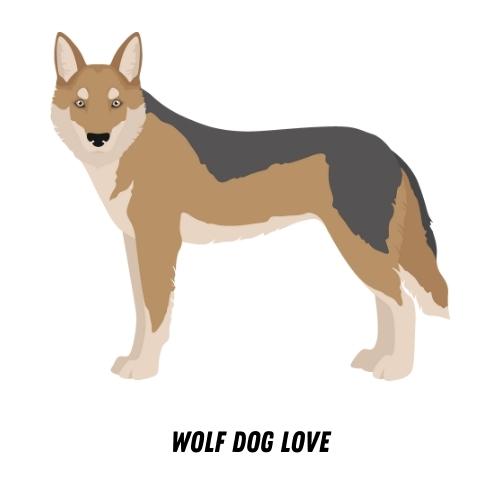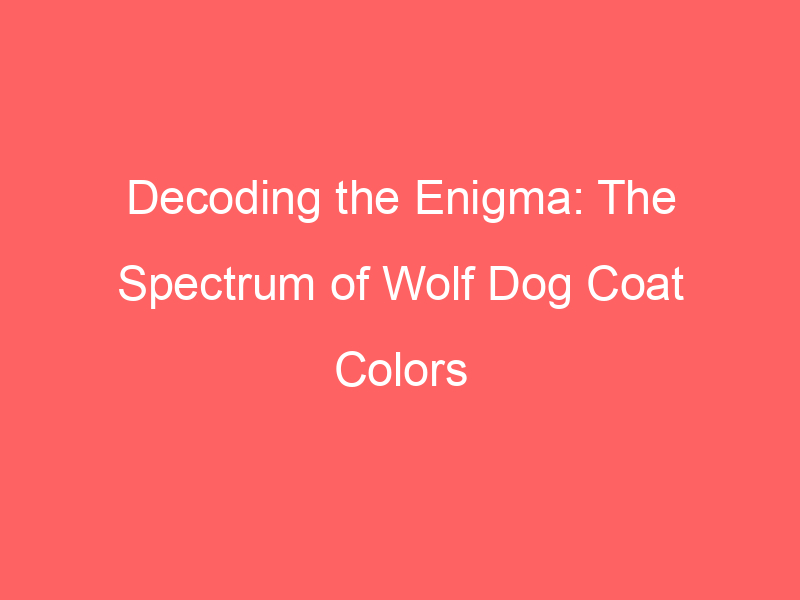Introduction to Wolf Dog Coat Color Genetics
Have you ever wondered why wolf dogs come in such a variety of beautiful colors? The answer lies in their genetics. This blog post will take you on a fascinating journey into the world of wolf dog coat color genetics.
- Understanding the basics of wolf dog coat colors
- The role of genetics in determining wolf dog coat colors
Wolf dogs, a hybrid of wolves and domestic dogs, exhibit a wide range of coat colors. These can range from pure white, through various shades of grey, to deep black. Some wolf dogs even have red, brown, or cream-colored coats. The color of a wolf dog’s coat is determined by the pigments produced by its cells. These pigments are controlled by genes, which are segments of DNA inherited from the parent animals.
Genetics play a crucial role in determining the coat color of a wolf dog. Each wolf dog inherits two sets of genes, one from each parent. These genes interact in complex ways to determine the color and pattern of the wolf dog’s coat. For example, a gene called the Agouti gene can cause the hairs to be banded with multiple colors, creating a “wild” or “wolf-like” appearance. Another gene, known as the K locus, can suppress the Agouti gene, leading to a solid black or solid white coat.
In conclusion, the coat color of a wolf dog is a fascinating blend of genetics and chance. Each wolf dog is unique, with its own combination of genes contributing to its beautiful and diverse coat colors. So, the next time you see a wolf dog, take a moment to appreciate the complex genetic dance that created its stunning coat.
Understanding Wolf Dog Breeds and Their Color Variations
Wolf dogs are a fascinating blend of domestic dog and wild wolf. They come in a variety of breeds, each with its unique characteristics and color variations. Let’s explore some of the most common wolf dog breeds.
Common Wolf Dog Breeds
-
Siberian Husky:
The Siberian Husky, known for its striking blue or multi-colored eyes and wolf-like features, is a popular breed. Their coat colors range from black to pure white, with many shades in between, including silver, red, and brown.
-
Alaskan Malamute:
Alaskan Malamutes are large, sturdy dogs with a wolf-like appearance. They are known for their thick coat, which comes in various colors such as black, sable, and shades of gray and white.
-
German Shepherd:
German Shepherds are known for their intelligence and versatility. Their coat color is most commonly black and tan, but they can also be sable, black, blue, and white.
-
Czechoslovakian Wolfdog:
The Czechoslovakian Wolfdog is a unique breed that originated from a German Shepherd and Carpathian wolf. They have a variety of coat colors, including yellow-grey, silver-grey, and dark grey.
Understanding the different wolf dog breeds and their color variations can help you appreciate the diversity and beauty of these unique animals. In the next section, we will delve deeper into the color variations in different wolf dog breeds.
Color Variations in Different Wolf Dog Breeds
Wolf dogs are a fascinating blend of wild and domesticated canines. They come in a variety of colors, each more captivating than the last. Let’s delve into the world of wolf dog color patterns and the genetics behind them.
- Understanding Wolf Dog Color Patterns
- Genetics of Wolf Dog Colors in Different Breeds
Wolf dogs can exhibit a wide range of color patterns. They can be solid, bi-colored, or even tri-colored. The most common colors include black, white, gray, brown, and tan. Some wolf dogs may have a solid coat of one color, while others may have a mix of two or three colors. The color distribution can also vary, with some wolf dogs having a more even color spread, while others may have distinct patches of different colors.
For example, a wolf dog could have a base coat of gray with patches of white and black. Another might be primarily brown with streaks of white and black. The color pattern of a wolf dog is one of the many features that make them unique and beautiful.
The color of a wolf dog’s coat is determined by its genetics. Each parent contributes genes that determine the color and pattern of the pup’s coat. The combination of these genes results in the unique color patterns we see in different wolf dog breeds.
For instance, if a wolf dog has a gene for black color from one parent and a gene for white color from the other, the resulting pup could be a mix of black and white. Similarly, a wolf dog with genes for brown and white colors could result in a pup with a brown and white coat. The exact color and pattern depend on the combination of genes the pup inherits from its parents.
Understanding the color variations in different wolf dog breeds can help us appreciate the beauty and diversity of these magnificent creatures. It’s a testament to the wonders of nature and the intricate workings of genetics.
The Mystery of Wolf Dog Coat Colors
Wolf dogs are fascinating creatures, and one of their most intriguing features is their coat color. The variety of shades and patterns can be quite a mystery. Let’s delve into this captivating topic and decode the secrets of wolf dog coat color inheritance.
Decoding the Wolf Dog Coat Color Inheritance
Just like in humans, the color of a wolf dog’s coat is determined by its genes. These genes are like instructions that tell the body what color to make the fur. But how does this work exactly? Let’s find out.
- How genetics play a role in coat color inheritance
- Examples of coat color inheritance in wolf dogs
Each wolf dog inherits two sets of genes, one from each parent. These genes come in pairs, and each pair controls a different aspect of the coat color. For example, one pair might control whether the coat is black or brown, while another pair might control whether there are any white patches. The combination of these genes creates the unique coat color of each wolf dog.
Let’s look at some examples to understand this better. Suppose a wolf dog has a gene for black fur from its mother and a gene for brown fur from its father. The black gene is dominant, so the wolf dog will have a black coat. However, if it also has a gene for white patches from one parent, it might have a black coat with white patches. Isn’t that interesting?
Understanding the genetics of wolf dog coat colors can help us appreciate the beauty and diversity of these magnificent creatures. It’s like solving a fascinating puzzle, where each piece adds to the overall picture. So, the next time you see a wolf dog, remember the complex genetic code that gives it its unique coat color.
Unusual Wolf Dog Coat Colors
While most of us are familiar with the common wolf dog coat colors like black, white, and grey, there are some rare and unique colors that can leave us in awe. These unusual colors are a result of complex genetic interactions and can sometimes be seen in certain wolf dog breeds.
- Exploring rare and unique wolf dog coat colors
- Case studies of wolf dogs with unusual coat colors
One such rare coat color is the blue coat. This is not a bright blue but rather a diluted black that appears bluish in certain light. This color is often seen in the Blue Bay Shepherd breed, a wolf dog hybrid. Another unusual color is the liver or chocolate color. This is a result of a recessive gene that dilutes the black pigment to a brown color. The liver color is often seen in the Saarloos Wolfdog breed.
Then there are the agouti and sable colors which are more common in wild wolves but rare in wolf dogs. The agouti color is a mix of black, grey, and tan, giving the coat a wild and rustic look. The sable color is similar but has more black and less tan. These colors are often seen in the Czechoslovakian Wolfdog breed.
Let’s look at a few case studies to understand these unusual coat colors better. A Blue Bay Shepherd named Kurgan is a perfect example of the blue coat color. His coat appears black in normal light but shines blue in sunlight. Another example is a Saarloos Wolfdog named Bruno who has a beautiful liver-colored coat. His coat is a rich chocolate brown, unlike the common grey or black wolf dog coats.
Then there is a Czechoslovakian Wolfdog named Luna who has a unique agouti-colored coat. Her coat is a mix of black, grey, and tan, giving her a wild and rustic look. Another Czechoslovakian Wolfdog named Max has a sable-colored coat. His coat is predominantly black with some tan, giving him a majestic and regal look.
These unusual wolf dog coat colors are not just visually appealing but also provide us with a deeper understanding of the complex world of genetics. They remind us of the beauty of diversity and the wonders of nature.
Wolf Dog Hybrid Coat Colors
Wolf dog hybrids, a unique blend of domestic dog and wild wolf, are known for their striking coat colors. These colors can range widely, reflecting the rich genetic heritage of these animals. Let’s delve deeper into understanding the spectrum of wolf dog hybrid coat colors.
Understanding the Spectrum of Wolf Dog Hybrid Coat Colors
Wolf dog hybrid coat colors are a fascinating topic. The coat color of these animals is influenced by a variety of factors, including their wolf and dog parentage. Understanding this spectrum requires a basic knowledge of genetics and how hybridization affects coat color.
- How hybridization affects coat color
- Examples of color variations in wolf dog hybrids
- Black: This color is often seen in hybrids with a high percentage of wolf genes. The black coat is dense and thick, providing excellent camouflage in the wild.
- Gray: Gray is a common color in wolf dog hybrids. This color can range from light silver-gray to dark charcoal.
- White: White wolf dog hybrids are rare but do exist. These animals have a pure, snowy white coat that is incredibly striking.
- Brown: Brown wolf dog hybrids can have a coat that ranges from light tan to deep chocolate brown.
Hybridization, or the process of combining the genetic material of two different species, significantly impacts the coat color of wolf dog hybrids. The color of a wolf dog hybrid’s coat is determined by the combination of genes it inherits from its wolf and dog parents. For example, if a wolf with a gray coat mates with a dog with a black coat, the resulting hybrid might have a coat that is a blend of these two colors.
Wolf dog hybrids can exhibit a wide range of coat colors. Some common color variations include:
In conclusion, the coat colors of wolf dog hybrids are as diverse as the animals themselves. By understanding the role of hybridization and the genetic influences at play, we can better appreciate the stunning array of colors seen in these unique creatures.
Key Takeaways: Understanding Wolf Dog Coat Colors
As we wrap up our exploration of wolf dog coat colors, let’s revisit some of the most important points we’ve learned. These key takeaways will help you better understand the fascinating world of wolf dog genetics and the stunning variety of coat colors these animals can have.
- The role of genetics in determining coat color: Just like in humans, a wolf dog’s coat color is determined by its genes. Each parent contributes one set of genes to their offspring, and these genes determine the color of the wolf dog’s coat. For instance, if a wolf dog inherits a gene for black color from one parent and a gene for white color from the other, it may end up with a coat that is a mix of black and white. This is a simplified explanation, and the actual process involves multiple genes and can result in a wide variety of coat colors and patterns.
- The impact of breed on color variations: The breed of a wolf dog can also influence its coat color. Different breeds have different genetic makeups, and this can result in different coat colors. For example, a Siberian Husky wolf dog might have a different coat color than a German Shepherd wolf dog, even if they have the same wolf parent. This is because the genes from the dog parent can influence the coat color just as much as the genes from the wolf parent.
- The mystery and beauty of wolf dog coat colors: Despite our understanding of genetics and breed influences, there is still a lot of mystery surrounding wolf dog coat colors. Sometimes, a wolf dog might have a coat color that doesn’t seem to match either of its parents. This can be due to hidden genes, or genes that were present in the parents but didn’t show up in their own coat colors. These surprises add to the beauty and fascination of wolf dog coat colors, making each wolf dog truly unique.
In conclusion, the world of wolf dog coat colors is a complex and beautiful one, filled with a variety of colors and patterns. By understanding the role of genetics and breed influences, we can better appreciate the stunning diversity of these magnificent animals.








